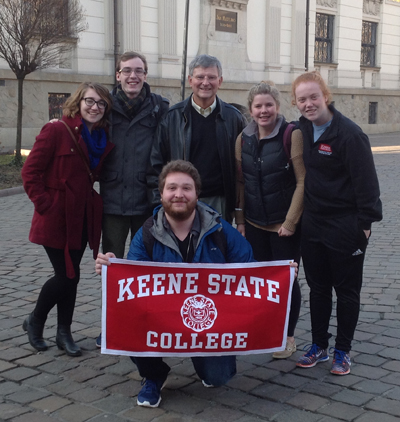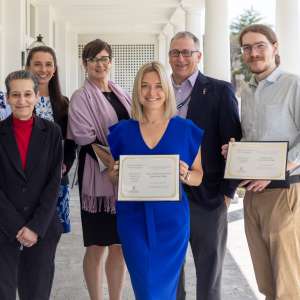Reflections from Kraków

About this time last year, we told you that Professor and Chair of Holocaust and Genocide Studies C. Paul Vincent had been selected for a Fulbright U.S. Scholar Grant that enabled him to spend the spring 2015 semester teaching at Jagiellonian University’s Centre for European Studies in Krakow, Poland. It’s been quite a rewarding experience, and we’ll be sharing more exciting news about his work at Jagiellonian soon. Last month, he sent us a story that reaches back into Poland’s World War II history—and Dr. Vincent’s personal history. It’s too good not to share:
Sunday, 15 March. I took part in today’s March of Remembrance from the former assembly square (it served as both Appellplatz and Umschlagplatz) in Podgórze to the site of the former Płaszów concentration camp—roughly 3–4 kilometers away. Joining the march were four of our Keene States students, now studying at the Centre for European Studies, as well as Dr. Annamaria Orla-Bukowska, a professor with Jagiellonian’s Institute of Sociology. This semester Annamaria is teaching Nationalism and Racism; the KSC students are all enrolled. I’m guessing that roughly 400 people took part in today’s march, the vast majority being Catholic Poles from Kraków. The event began at noon with a brief ceremony near a famous apothecary at the edge of the ghetto where the pharmacist became renowned for providing life-saving assistance to ghetto Jews. The considerable police presence throughout the march was impressive; while informed that a police presence is normal, it was beefed up this year due to the participation of Israel’s Ambassador, Anna Azari, who had traveled to Kraków from Warsaw. But I was most impressed by our Keene State students. I often tell students that we are separated from historical events by time and space. Lacking some magic, space is the only variable we are capable of removing. Watching our students absorb today’s experience was a poignant reminder of the importance of our work at Keene State in Holocaust and Genocide Studies.
Begin pull-quote…Watching our students absorb today’s experience was a poignant reminder of the importance of our work at Keene State in Holocaust and Genocide Studies. …end pull-quote
The annual March of Remembrance is always scheduled on the Sunday closest on the calendar to the actual date when the Nazis evacuated the Kraków ghetto. In lockstep with the tragedy that consumed the vast majority of Polish Jewry, Kraków’s ghetto was evacuated on 13 March 1943 with untold brutality. Those who have seen Spielberg’s Schindler’s List witnessed a reenactment of that event, portrayed just at the moment when Oskar Schindler, standing with his mistress on a bluff overlooking Podgórze, notices for the first time the humanity of the wretched people below him. In a movie filmed otherwise in black-and-white, recognition comes when Schindler rests his eyes on a little girl dressed in a red coat. The moment serves as a catalyst for the rescue of 1,000 Jews.
A Turning Point for the Nazis
Desperation factored into the action taken by the Nazis in the spring of 1943 against the vast majority of ghettos in Poland. The Third Reich had recently suffered its most devastating defeat in the war to date: On 31 January 1943, General Field Marshal Friedrich Paulus, acting against Hitler’s explicit orders, had surrendered his army of more than 90,000 men at Stalingrad to the Soviets. For the first time since the invasion of Poland in September 1939, many Germans confronted the realization that Hitler could lose the war. The mental crisis inspired Joseph Goebbels, Hitler’s propaganda minister, to deliver his infamous “Total War” speech in Berlin’s Sportpalast on 18 February, claiming that 2,000 years of European history were at stake without German resolve and German sacrifice. The culprit for Germany’s failures was “the Jew,” he remarked. Hardened Nazis, embracing the preposterous myth that Jews had entrapped Germany into the war, were only too willing to redouble their resolve to eliminate their country’s mortal enemy. The evacuation of Kraków’s ghetto was a piece of this resolve; the turn of Warsaw would follow in April. Indeed, the attempt in February and March to deport the Jewish spouses of Aryan women—an effort that was foiled by the Rosenstrasse protest in Berlin—was also an indicator of growing Nazi desperation.
The Adventures of Franciszek Pruszynski
I’ve been reflecting of late on the adventurous life of Franciszek Pruszynski. In 1919, just as Poland was being reconstituted as a nation-state after a 120-year hiatus under foreign control—Poland had been partitioned by Prussia, Russia, and Austria in the 18th century—Franciszek chose to leave his homeland. After purchasing a ticket from a local Jewish peddler, he took passage to New York. Franciszek was born in the 1890s in the village of Pruszanka Stara, roughly equidistant between Łomża to the northwest and Białystok to the northeast. It remains a tiny spot on the Polish map that apparently served as home to the Pruszynski clan for several generations. Franciszek later related to his children how he traveled by horse and cart with his father, Aleksander, to Białystok; indeed, he spoke of his father traveling in like manner to distant Lwów (known then as Lemberg and situated in Austrian Galicia).
Franciszek met his wife on that voyage to America, changed his name upon arriving in New York to Frank (or, perhaps, his name was changed for him at Ellis Island), and then settled initially in Minneapolis. The couple’s first child, Kazimier Vincent Pruszynski, was born in 1921. Kazimier changed his name in 1946 to Cass Vincent; I arrived the next year. Cass, who died last year, often said that he owed his American heritage to a Jewish peddler from the village of Pruszanka. His records, I discovered, were full of donations to Jewish causes, including the Cohen Center for Holocaust and Genocide Studies. I think he owed this commitment to his father. As I walked with our students and with several hundred Polish Catholics from Podgórze to the site of the former Płaszów concentration camp, I imagined my father and grandfather walking along beside me. Perhaps we were joined by that Jewish peddler.





